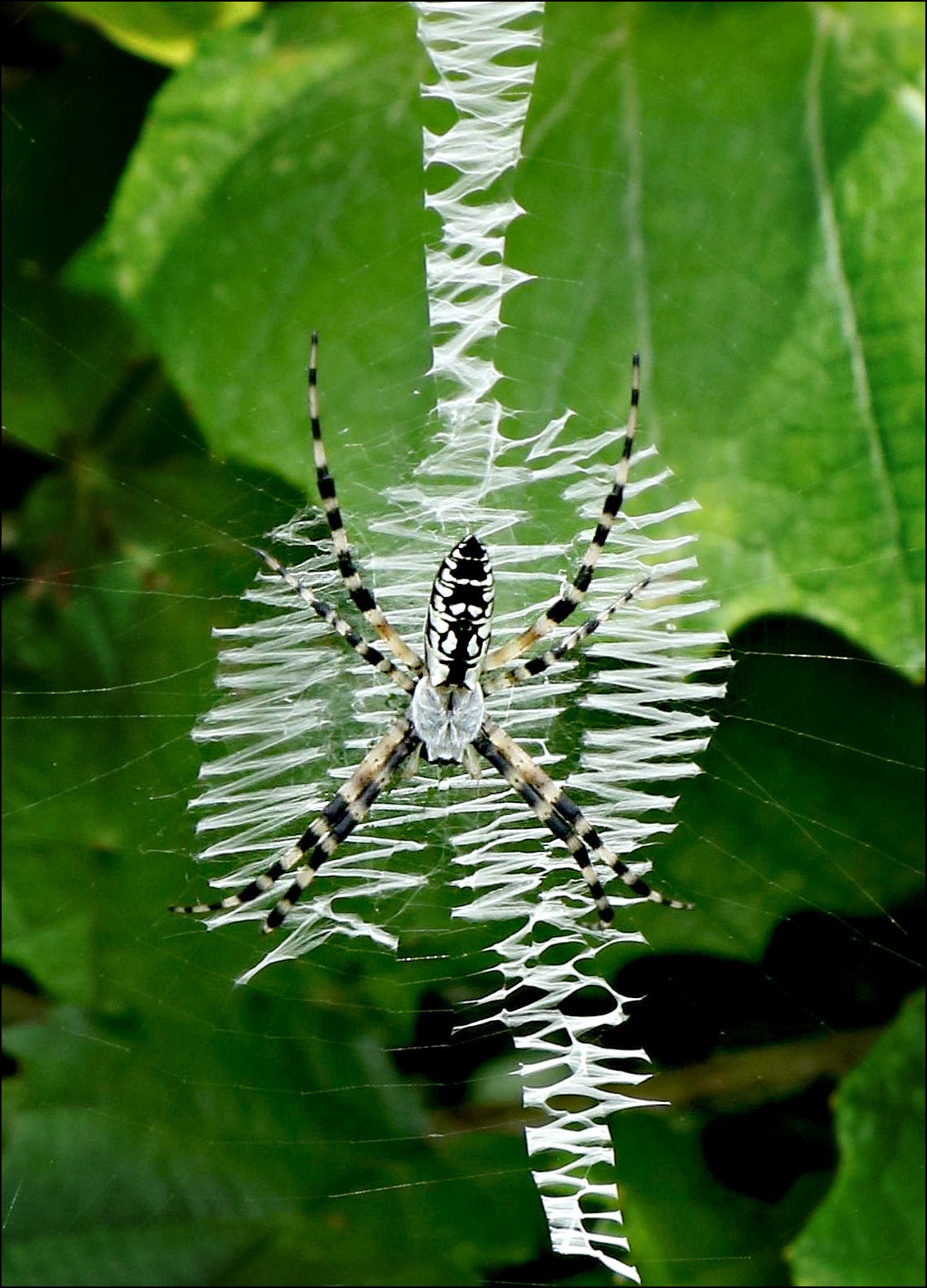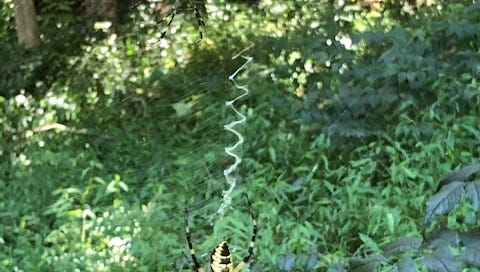Welcome to Natural Wonders! I’ve been on an arachnid and insect kick lately, writing about ticks and spiders and ants and bees. I’ll try to branch out next week to animals without exoskeletons or even plants. It’s just been a buggy sort of summer…
You may have figured out from my last newsletter that I am not a lover of spiders. I realize I should appreciate the uniqueness and contributions of every animal, insect, and plant, but I’ll admit that spiders give me the creeps.
Maybe it’s because they’re small, I know they can bite, and therefore they could be anywhere on me without my realizing it. Or perhaps it’s the claustrophobic feeling I get when I feel their webs draped over my arms, my face, my neck and I can’t find the actual spider that I know is somehow attached and tiptoeing with its tiny feet to burrow deep into my hair.
Or maybe I too vividly remember Bilbo Baggins in the giant spider’s lair:
That’s the stuff of nightmares.
Weirdly, there is one spider I find fascinating, even though it’s big and spins webs just as large and sticky as any other spider. Perhaps it’s because I loved reading Charlotte’s Web as a child, but I think writing spiders are really fun to watch. They weave a creative zigzag pattern into the center of their webs, which are always tucked away in low-traffic areas, and it’s a fun surprise to find one since they’re a bit unusual.
We found one next to our house, nestled in amongst five Joro spiders under the cherry trees. At first it ran away as soon as I walked up, but then Andrew fed it a grasshopper and that brought it out:
Writing spiders are unique with their zigzag web pattern – why is that? Why don’t other types of spiders do the same? And what’s the purpose of the zigzag, anyway? Does it attract more bugs? If so, why aren’t all spiders doing it?
Why do writing spiders write?
Take a look at these thick zigzag patterns some spiders create – that’s got to take a lot of effort! I’ve not yet been able to watch one of them creating the patterns, but I imagine it takes quite a bit of time and uses up lots of their silk. Surely it’s got an important purpose?

These extra patterns on webs are called stabilimenta because originally people thought they helped stabilize the spider’s web (thus the name). We now know that’s not true because scientists have actually pulled those sections out (with an actual blowtorch and forceps, mind you) and the web didn’t collapse.
So, if it’s not there for support, what IS its purpose? Scientists aren’t in complete agreement, but here are some of their thoughts:
Perhaps it’s about camouflage

Spiders that build stabilimenta in their webs tend to be diurnal (they hunt during the day) and they like to hang out in the center of their webs. This makes them prime targets for spider-eating birds. When the spider creates the intricate pattern, it helps break up their silhouette so they’re not so obvious to predators. This theory about the purpose of decorated webs is supported by the fact that in Guam invasive snakes have killed off most of the predatory birds and, over time, fewer spiders are building stabilimenta in their webs.
Does it help them capture insects?
Spiders purposely build their webs to have some sticky sections for capturing prey (these are the spiral parts) and some non-sticky sections (the spokes) that they can tiptoe across without getting tangled in the web themselves.
It stands to reason that the zigzagged patterns must be extra sticky, right?
Actually, no. The stabilimentum is made of non-capture silk. It’s not sticky at all! But what it does do is reflect UV light at a much higher rate than the rest of the web. To an insect, the pattern on the web practically glows, and some studies have shown that webs decorated with these patterns catch more bugs per hour than undecorated webs. Even when only half the web was decorated, more insects flocked to that side than the plain-Jane side.
Is it a warning to other animals?
Webs take so much energy to build and maintain, it must be incredibly aggravating to have to rebuild it every time a bird flies through it, right? Could the patterns center-web actually be a stop sign to other animals to prevent them from destroying all their hard work?
Believe it or not, there is some research to support spiders creating stabilimentum as a defense mechanism. Spiders that have decorated webs tend to be those that hunt during the day and have webs they keep for several days at a time, whereas spiders that don’t have stabilimentum (that is, most spiders) rebuild their webs each day.
One group of scientists (the ones with the blowtorch I mentioned above) tested this theory by capturing some writing spiders and having them build their webs in large frames. They then arranged three of the frames into triangular formations around bird feeders. The scientists removed the stabilimenta from one web, made a similar-sized hole in the control web, and left one frame empty so birds could fly through if they chose.
The scientists found that having the zigzag pattern reduced the chances of birds crashing into the webs by 45%. That’s huge! Almost 50% of the webs remained intact because birds avoided the web decorations.
But there was a trade-off – webs that had the pattern were less successful at catching insects. Those spiders caught 34% fewer prey than the plain webs. Wait – didn’t the study above show decorated webs caught more insects, not fewer? Perhaps – this is where scientific methods come into play. The first study counted “web damage” as evidence of capturing prey whereas the second study actually collected the dead corpses.

So, while these spiders save energy by not having to rebuild their webs each day, there may be an drawback by having fewer crunchy bugs to eat.
Do the decorations attract mates?
The large writing spiders we see are all females. The males are much smaller and only come by to visit when it’s time to mate. When he arrives, the male plucks the strings of the web like a guitar to attract the female. But the joke’s on him – after he mates with the female, the male will experience seizures and die within half an hour. The female then wraps him up in silk and stashes him in the corner of the web for snacking on later. It seems that more males (or male corpses?) are found in the webs of writing spiders that decorate their webs than in those that don’t. So, perhaps stabilimenta are meant as “open for business” signs for prospective mates.
It seems there are many possibilities when it comes to the purpose of decorated webs. Perhaps spiders are simply creative and are laughing at our convoluted explanations of their individual art installations. It does help me appreciate spiders more – any animal that takes the time to stand out from the rest, regardless of the purpose, deserves a little respect, I think.
Do you have writing spiders near you? What do they write - the zigzag pattern like my resident spider, or more creative circles, Xs or spirals? Any chance you feed it like we do ours? (Andrew fed his local writing spiders as a child - scroll to the bottom to see how his mother memorialized this habit)
Weird Nature:
Detritus:
While we’re dealing with invasive Joro spiders, parts of Florida have been invaded by giant African land snails, which carry a parasite called rat lungworm.
Legend has it that if you tear down a writing spider’s web it will rebuild the next day and write your name on the web. When that happens… you are doomed to die.
Gorgeous photos from the International Landscape Photography Awards.
If you liked this issue, please click the “like” button below - it makes me happy and also raises the profile of this newsletter!







what about an issue on chiggers before you leave the insect world. have enjoyed your research findings and writing style.
That's so cool. I never knew that there was such as thing as a writing spider, I thought that Charlotte's web was just being particularly fanciful (that book traumatised me so much as a child).
That's an awesome wall hanging that Andrew's mother made. I love that she put a writing spider into it.